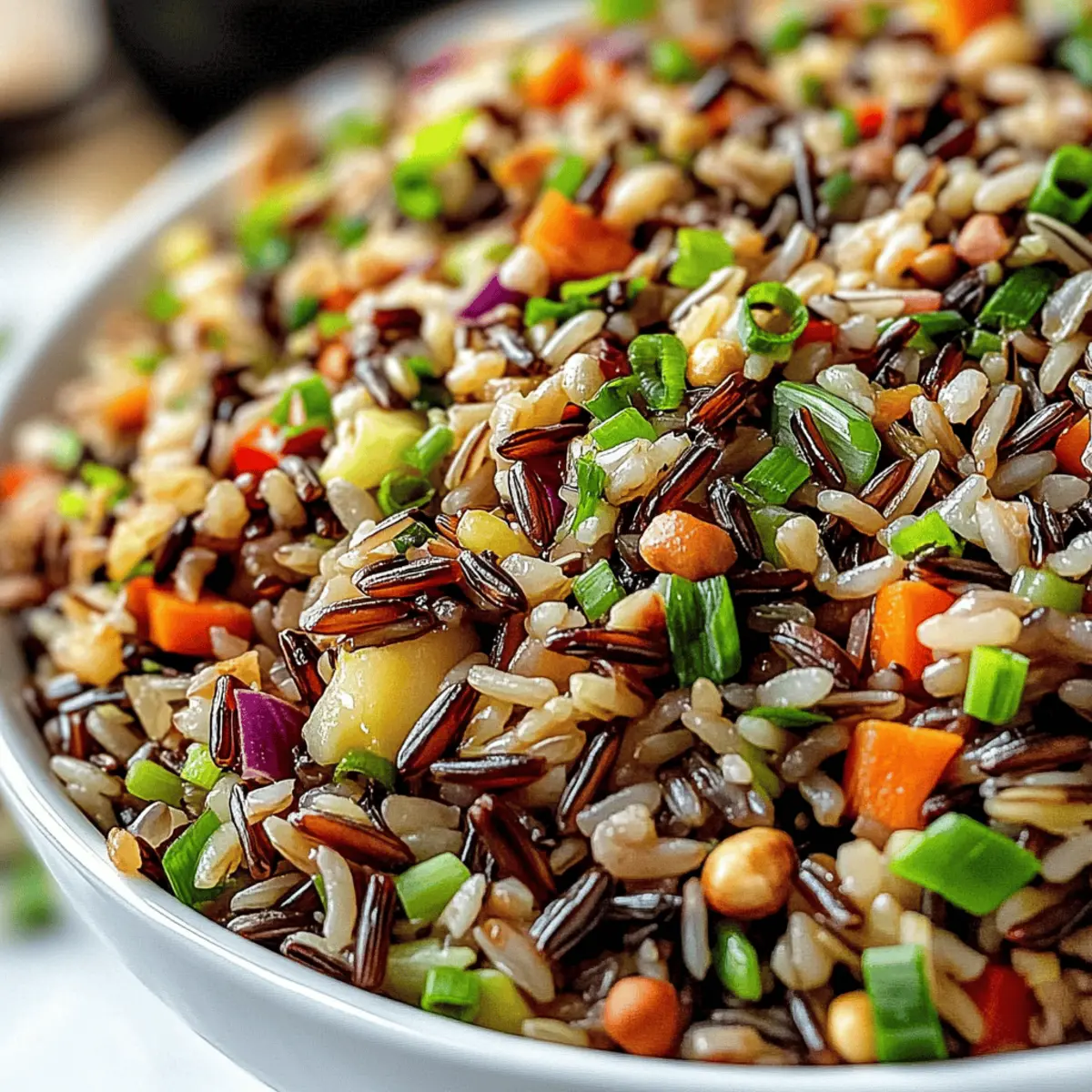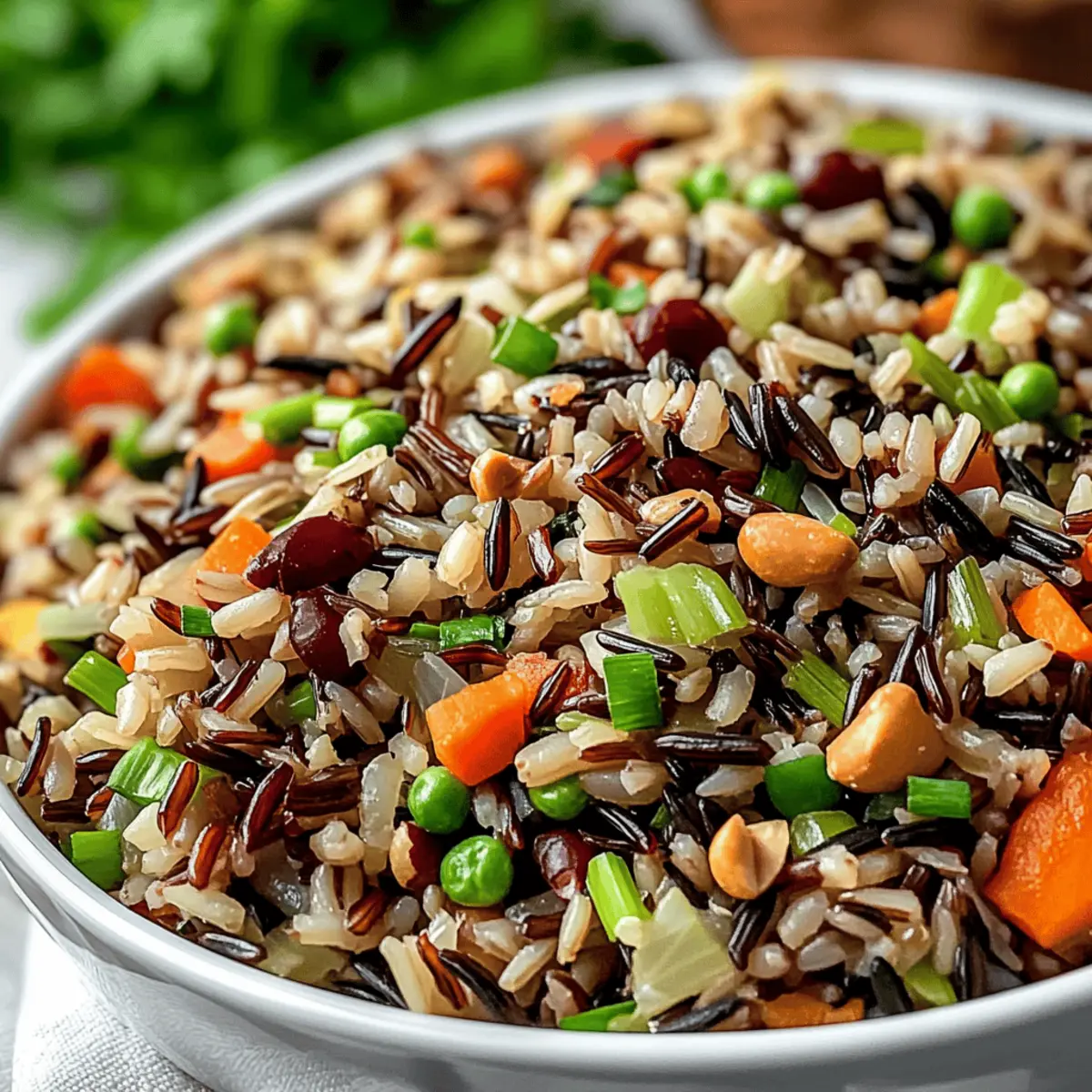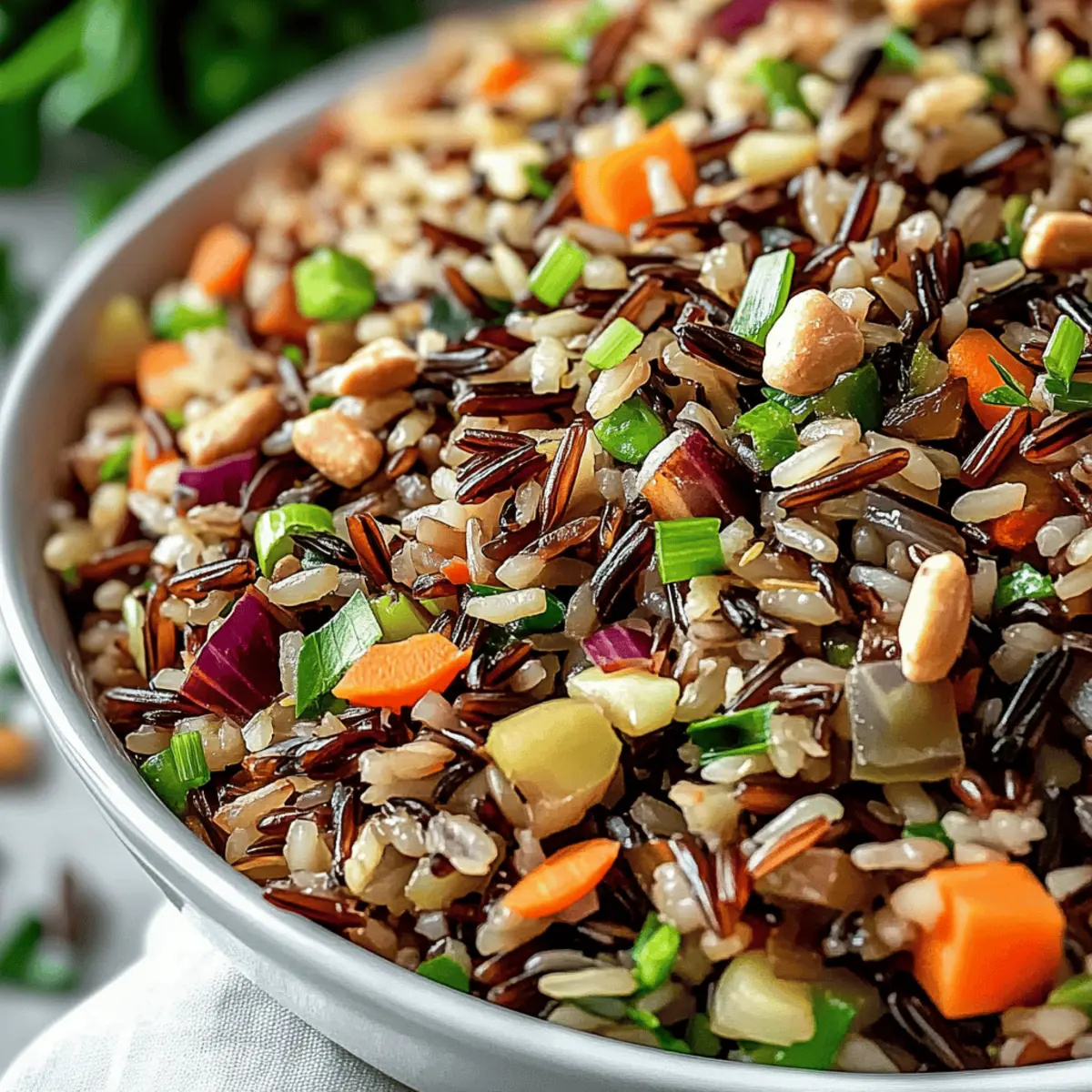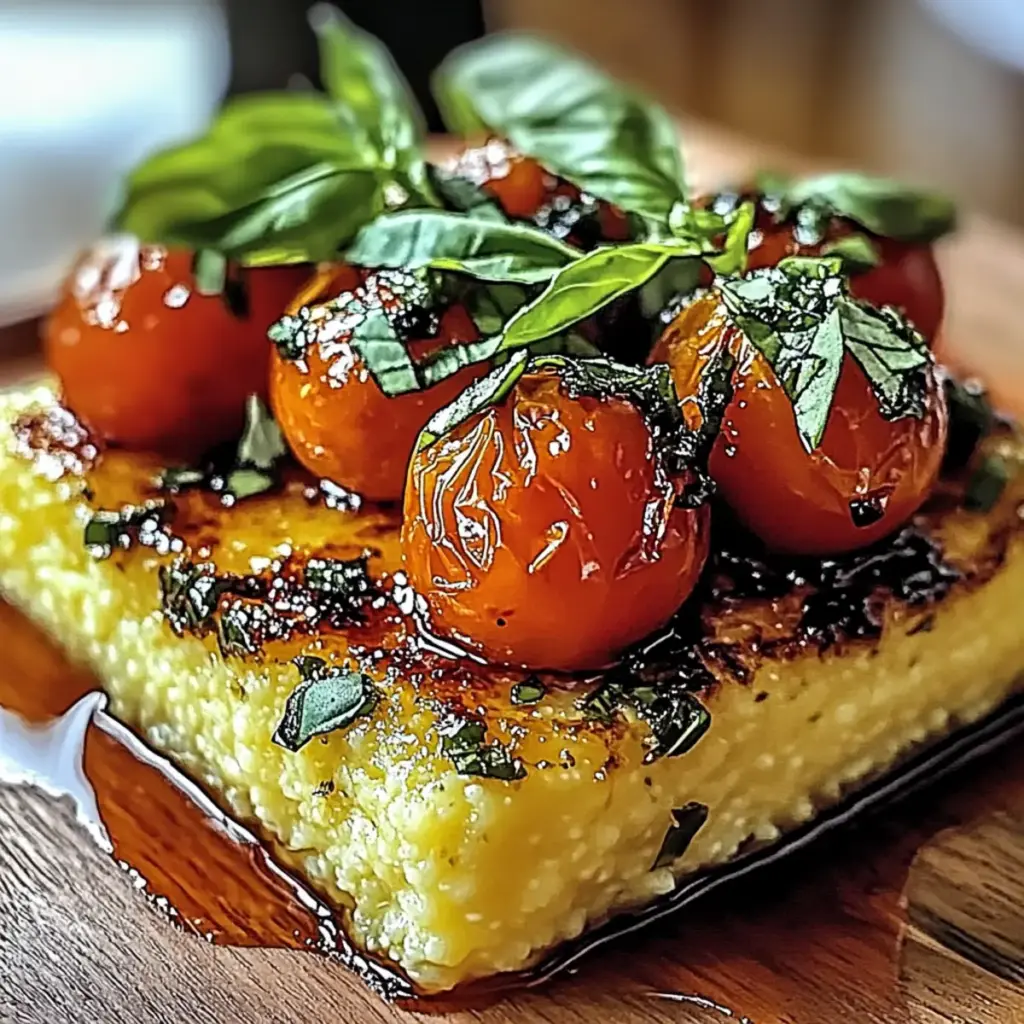Advertisement
The aroma wafting through my kitchen reminded me of family gatherings filled with laughter and warmth. This Hearty Wild Rice Pilaf is an ode to those moments, blending nutty wild rice with an array of colorful veggies and a touch of sweetness from dried cranberries. It’s not just any side dish; this versatile creation is perfect for both cozy dinners and festive occasions, offering a delightful texture that’s hearty yet light. Plus, it’s vegetarian-friendly and packed with nutrients—a guilt-free addition to your meal. Whether you’re hosting a holiday feast or a simple weeknight dinner, this wild rice pilaf will surely impress your guests. Are you ready to elevate your dining experience with this wholesome recipe?

Why is Wild Rice Pilaf a Must-Try?
Flavorful Fusion: This dish perfectly combines the nutty wild rice with colorful veggies, creating a mouthwatering taste adventure.
Nutrient-Packed: Loaded with fiber and antioxidants, it’s a healthy choice that supports your well-being.
Advertisement
Versatile Delight: Ideal as a side dish for roasted meats or stuffed bell peppers, it adapts effortlessly to any meal.
Quick & Easy: With straightforward steps, you can whip up this culinary treat in just under an hour.
Crowd-Pleasing: Whether for a cozy family dinner or a festive gathering, this wild rice pilaf will certainly garner rave reviews!
Wild Rice Pilaf Ingredients
• Elevate your meals with these essentials!
For the Pilaf
- Wild Rice Blend – The base providing delicious nuttiness; can substitute with brown rice for a different flavor.
- Vegetable Broth (or Chicken Broth) – Enhances flavor; opt for low-sodium broth for a healthier twist.
- Olive Oil or Butter – Adds richness for sautéing; use coconut oil for a dairy-free alternative.
- Onion – Gives aroma and sweetness when sautéed; substitute with shallots for a milder taste.
- Celery – Offers crunch and freshness; omit if you prefer a simpler dish.
- Carrot – Brings sweetness and color; replace with bell peppers or peas for a variety.
- Garlic – Essential for depth of flavor; always fresh is best, avoiding garlic powder.
- Dried Thyme & Dried Rosemary – Aromatic herbs enhancing the savory profile; fresh herbs can be used (double the amount).
- Dried Cranberries (optional) – Adds a sweet contrast; substitute with raisins or omit based on preference.
- Nuts (slivered almonds or chopped pecans, optional) – Delivers crunch and richness; swap with walnuts or sunflower seeds for a change.
- Green Onions – For garnish and mild onion flavor; chives work well as an alternative.
- Salt and Pepper – Essential seasonings to taste.
- Fresh Parsley (for garnish) – Boosts color and freshness; cilantro can be used instead for a different twist.
Step‑by‑Step Instructions for Hearty Wild Rice Pilaf with Veggies and Nuts
Step 1: Rinse the Wild Rice
Begin by rinsing 1 cup of wild rice blend in cold water under a fine mesh strainer. This process washes away any excess starch that can make the final dish gummy. Rinse until the water runs clear, which takes about 1–2 minutes, and then set the rice aside while you prepare the cooking liquid.
Step 2: Cook the Wild Rice
In a medium saucepan, bring 4 cups of vegetable broth to a rolling boil over high heat. Carefully stir in the rinsed wild rice, then reduce the heat to low. Cover the saucepan and let it simmer for 40–50 minutes, or until the rice is tender and has absorbed the liquid. Once done, remove from heat and let it sit covered for an additional 5 minutes before fluffing with a fork.
Step 3: Sauté the Vegetables
While the rice is cooking, heat 2 tablespoons of olive oil or butter in a large skillet over medium heat. Add 1 diced onion, 1 chopped celery stalk, and 1 diced carrot to the skillet. Sauté these vegetables for about 5–7 minutes, stirring occasionally, until they become tender and aromatic, showcasing a vibrant color.
Step 4: Add Herbs and Garlic
Once the vegetables are softened, add 2 minced garlic cloves, 1 teaspoon of dried thyme, and 1 teaspoon of dried rosemary to the skillet. Stir these ingredients for about 1 minute, allowing the fragrant aroma to fill your kitchen. This step enhances the savory profile of your wild rice pilaf beautifully.
Step 5: Combine Rice and Vegetables
Carefully add the cooked wild rice to the skillet with the sautéed vegetables. Stir in 1/2 cup of dried cranberries and 1/2 cup of slivered almonds or chopped pecans for added crunch. Toss everything together gently to combine, ensuring that the rice is well mixed with the vegetables and other ingredients.
Step 6: Final Seasoning and Serve
Season the mixture with salt and pepper to taste, adjusting according to your preference. Gently heat everything through for an additional 2–3 minutes on the stove. Transfer the hearty wild rice pilaf to a serving dish, garnishing it with sliced green onions and fresh parsley for a pop of color before serving to your guests.

Expert Tips for Wild Rice Pilaf
Cooking Time Matters: Ensure the wild rice is fully cooked and the liquid absorbed for the best texture; undercooked rice can ruin the dish.
Avoid Overcrowding: When sautéing, don’t overcrowd the skillet; cook in batches if necessary to ensure even cooking and prevent steaming.
Herb Adjustments: Adjust the amount of herbs depending on your taste preference for a customized flavor; fresh herbs should be doubled when replacing dried ones.
Garnish Wisely: If making ahead, save garnishes like fresh parsley and green onions for just before serving to maintain their vibrant appearance.
Enhance Flavor: For a deeper umami flavor, consider swapping vegetable broth for mushroom broth; it adds a whole new depth to your wild rice pilaf.
Wild Rice Pilaf Variations & Substitutions
Feel free to make this wild rice pilaf your own by mixing in these delightful alternatives!
- Dairy-Free: Substitute butter with coconut oil for a creamy texture without the dairy.
- Veggie Boost: Toss in fresh spinach or kale during the last few minutes of cooking for added nutrition.
- Sweet Twist: Replace dried cranberries with chopped apples or fresh grapes for a refreshing sweetness.
- Flavor Depth: Use mushroom broth instead of vegetable broth for a richer umami flavor experience. It’s a small swap that makes a big difference!
- Nutty Crunch: Experiment with walnuts or sunflower seeds instead of slivered almonds for a different crunch.
- Spice It Up: Stir in a pinch of red pepper flakes or a diced jalapeño for a gentle kick that warms the palate.
- Herb Variety: Fresh herbs like basil or cilantro can replace thyme and rosemary. Just remember to double the quantity for a burst of fresh flavor.
- Texture Change: Swap wild rice for a quinoa blend for a lighter, fluffy alternative that suits any gathering.
Each variation offers a unique twist, allowing you to cater the dish to your family’s tastes or the occasion. If you’re looking for other delicious side dish inspirations, check out my stuffed bell peppers or explore more on the benefits of using vegetable broth!
Make Ahead Options
These Hearty Wild Rice Pilaf with Veggies and Nuts are perfect for meal prep enthusiasts looking to save time during busy weeknights! You can prepare the wild rice up to 3 days in advance and refrigerate it in an airtight container. Additionally, chop your vegetables—onion, celery, and carrot—and store them together for up to 24 hours to keep them fresh and ready to sauté. When you’re ready to serve, simply heat your cooked wild rice and sauté the vegetables for a quick mix, adding in any remaining ingredients like cranberries and nuts, and garnish just before serving. This way, you’ll enjoy a delicious, homemade side that’s just as vibrant and flavorful!
How to Store and Freeze Wild Rice Pilaf
Refrigerator: Store the wild rice pilaf in an airtight container for up to 3 days. Make sure it’s completely cool before sealing to maintain freshness.
Freezer: Freeze the pilaf in an airtight container for up to 3 months. Consider portioning it into smaller containers for easy reheating later.
Reheating: When ready to enjoy, reheat in a skillet over medium heat, adding a splash of vegetable broth to revive the texture and flavors.
Keep It Fresh: For the best taste, avoid refreezing thawed wild rice pilaf; it’s best enjoyed fresh or after one freeze.
What to Serve with Hearty Wild Rice Pilaf?
This delightful pilaf makes every meal feel special, so let’s talk about what to accompany it for a wholesome feast.
-
Roasted Chicken: The juicy flavors of roasted chicken harmonize perfectly with the nutty rice, creating a comforting plate. The crispy skin adds a satisfying crunch that complements the tender pilaf beautifully.
-
Grilled Vegetables: Charred zucchini, bell peppers, and asparagus bring a vibrant flavor and texture to your meal. Their smoky notes elevate the earthiness of the wild rice, ensuring every bite is fresh and fulfilling.
-
Stuffed Bell Peppers: These hearty veggies filled with cheese, grains, or meat are a wonderful match. They mirror the pilaf’s colorful charm while providing a wholesome unity in flavors and textures.
-
Cranberry Sauce: A side of homemade cranberry sauce introduces a burst of sweetness that enhances the dried cranberries in the pilaf. Just a spoonful on top amplifies the festive feel of your dish.
-
Mixed Green Salad: A crisp salad with peppery arugula and sweet cherry tomatoes adds brightness and a refreshing crunch. Toss in a light vinaigrette for a lively contrast to the warm pilaf.
-
Chardonnay: This smooth, dry white wine complements the nuttiness and richness of the rice while enhancing the overall dining experience. Its fruity notes pair seamlessly with the cranberries and fresh herbs.
-
Apple Crisp: To cap off your meal, a warm apple crisp topped with vanilla ice cream provides a delightful sweet contrast to the savory pilaf. The cinnamon apple flavors will evoke warm memories of family gatherings.

Wild Rice Pilaf Recipe FAQs
How do I choose the right wild rice for this recipe?
Absolutely! When selecting wild rice, look for a blend that consists of whole grains, aiming for a mix with varying colors for a delightful presentation. Properly dried wild rice should feel firm and slightly crunchy. Avoid any packages that contain broken grains or have dark spots, as these may indicate spoilage.
What is the best way to store leftovers?
Very simple! To store your wild rice pilaf, allow it to cool completely and then transfer it to an air-tight container. It will stay fresh in the refrigerator for up to 3 days. Just be sure to check for any off-smells before using it again.
Can I freeze wild rice pilaf, and if so, how?
Definitely! Freezing the pilaf is a great option if you want to save some for later. Allow it to cool completely and then portion it into smaller, airtight containers or freezer bags. Label them with the date, and it can be stored in the freezer for up to 3 months. When you’re ready to enjoy it, just thaw it in the refrigerator overnight and reheat in a skillet with a splash of vegetable broth for optimal texture.
What if my wild rice remains chewy or is undercooked?
Don’t worry; it happens! If your wild rice is chewy after the recommended cooking time, try adding a little more liquid (broth or water) to the saucepan and simmering for an additional 10 minutes. Make sure the lid is on tightly to trap steam, and check periodically until the rice is tender and the liquid is absorbed.
Is this wild rice pilaf suitable for people with allergies?
Absolutely! However, you should always keep dietary restrictions in mind. This recipe is naturally vegetarian but does include nuts, which can be a common allergen. If nut allergies are a concern, simply omit the nuts or consider substituting them with sunflower seeds. Additionally, ensure that any broth used does not contain allergens relevant to your guests.

Savory Wild Rice Pilaf with Colorful Veggies and Nuts
Ingredients
Equipment
Method
- Rinse the wild rice blend in cold water under a fine mesh strainer until the water runs clear. Set aside.
- In a medium saucepan, bring vegetable broth to a rolling boil. Stir in the rinsed wild rice, reduce heat to low, cover, and simmer for 40-50 minutes until tender. Let sit covered for 5 minutes before fluffing.
- Heat olive oil or butter in a large skillet over medium heat. Sauté diced onion, chopped celery, and diced carrot for 5-7 minutes until tender and aromatic.
- Add minced garlic, dried thyme, and dried rosemary to the skillet. Stir for 1 minute to enhance the flavor.
- Combine cooked wild rice with the sautéed vegetables in the skillet. Stir in dried cranberries and slivered almonds or pecans.
- Season with salt and pepper to taste and heat through for 2-3 minutes. Transfer to a serving dish, garnishing with sliced green onions and fresh parsley.






